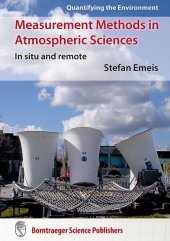 Neuerscheinungen 2010Stand: 2020-01-07 |
Schnellsuche
ISBN/Stichwort/Autor
|
Herderstraße 10
10625 Berlin
Tel.: 030 315 714 16
Fax 030 315 714 14
info@buchspektrum.de |

Stefan Emeis
Measurement Methods in Atmospheric Sciences
In situ and remote
2010. XIV, 257 p. w. 28 tabs.
Verlag/Jahr: BORNTRAEGER 2010
ISBN: 3-443-01066-0 (3443010660)
Neue ISBN: 978-3-443-01066-9 (9783443010669)
Preis und Lieferzeit: Bitte klicken
Measurement Methods in Atmospheric Sciences
provides a comprehensive overview of in-situ and remote sensing measurement
techniques for probing the Earth atmosphere. The methods presented in this book span the entire range from classical meteorology via atmospheric chemistry and micrometeorological flux determination to Earth observation from space. Standard instruments for meteorological and air quality monitoring methods, as well as specialized instrumentation predominantly used in scientific experiments, are covered. The presented techniques run from simple mechanical sensors to highly sophisticated electronic devices. Special emphasis is on the rapidly evolving field of remote sensing techniques. Here, active ground-based remote sending techniques such as SODAR and LIDAR find a detailed coverage. The book conveys the basic principles of the various observational and monitoring methods, enabling the user to identify the most appropriate method. An introductory chapter covers general principles (e.g. inversion of measured data, available platforms, statistical properties of data, data acquisition). Later chapters each treat methods for measuring a specific property (e.g. humidity, wind speed, wind direction). Long chapters provide an introductory tabular list of the methods treated. More than 100 figures and 400 references, mostly to the recent scientific literature, aid the reader in reading up on the details of the various methods at hand. Recommendations at the end of each major chapter provide additional hints on the use of some instruments in order to facilitate the selection of the proper instrument for a successful measurement. A large number of national and international standards, providing precise guidelines for measuring and acquiring reliable, reproducible and comparable data sets are listed in the appendix. A dedicated index allows easy access to this valuable information. The book addresses undergraduate and graduate students in meteorological and atmospheric sciences, physical geography, ecology, environmental sciences, agriculture and related disciplines as well as scientists in the process of planning atmospheric measurements in field campaigns or working with data already acquired. Practitioners in environmental agencies and similar institutions will benefit from instrument descriptions and the extended lists in the appendix.


